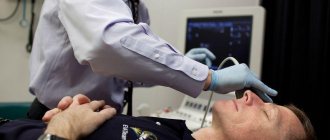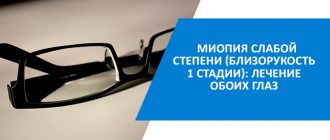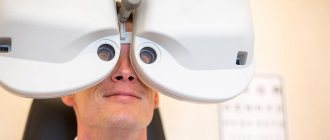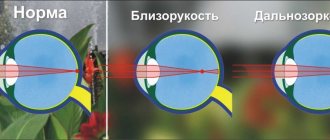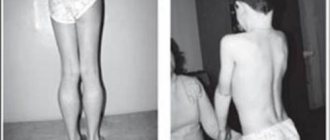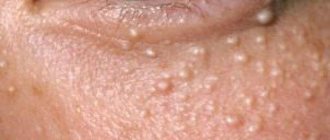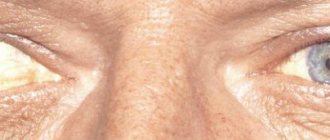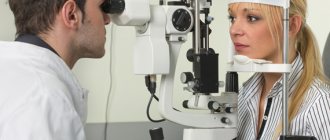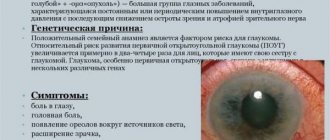Hypermetropia in children - what is it?
scheme for comparing the structure of the eye with normal, myopia and farsightedness
If farsightedness develops in a child of primary school age, he experiences difficulty reading, and may occasionally experience headaches and dizziness. Farsightedness is a pathology in which refraction is impaired; as a result of pathological processes, the child perceives objects as distorted. Normally, the image should be focused in the central part of the retina; with farsightedness, it is located behind the retina.
Refractive errors lead to a violation of refractive power, because of this the child poorly perceives objects located nearby.
Etiological factors in the development of childhood farsightedness
The reasons for the development of farsightedness in childhood are:
- genetic factors; malformations of the visual system, incorrect formation of eye structures;
- disturbance of intrauterine growth of the fetus;
- traumatic eye damage from chemical compounds or physical factors;
- conditions after infectious processes;
- operations on the visual organ;
- increased stress, eye fatigue;
- incorrectly selected glasses or contact lenses.
Degrees of disease: weak, medium and high
Degrees:
- 1st degree - Hypermetropia up to +2.0 D;
- 2nd degree - Hypermetropia from +2.25 D;
- 3rd degree - Hypermetropia more than +4.25 D.
If we consider congenital hypermetropia, the disease is most often diagnosed as moderate.
Some children are diagnosed with a high degree of farsightedness, and even if the baby is fully growing and developing, the disease is constantly progressing.
Generally accepted standards:
- At 1 year - + 2.5 D;
- At 2 years - + 2.0 D;
- At 3 years - + 1-1.5 D.
If a deviation is observed, the ophthalmologist suspects farsightedness, but an examination is required to confirm the diagnosis.
Progressive hypermetropia is dangerous because it can lead to strabismus and myopia.
Parents need to carefully monitor how the child perceives text and nearby objects. If hypermetropia develops, the baby does not clearly see letters and images. In this case, an examination by an ophthalmologist is necessary.
If symptoms of the disease are observed in a five-year-old child, correction should begin immediately.
Farsightedness should be treated before the child starts school.
Degrees of hypermetropia
Depending on the severity of visual impairment, three degrees of hypermetropia are distinguished:
- Weak – up to +2 diopters; Difficulties may arise when working visually at close range.
- Average – from +2 to +5 diopters; There are obvious difficulties with visual work at close range, distance vision may not deteriorate.
- High – over +5 diopters, there is a pronounced decrease in vision (distance and near).
In the early stages of the disease, regular performance of special eye exercises provides a good therapeutic effect.
Causes: congenital and acquired farsightedness
refraction of light in hypermetropia and myopia
Hypermetropia develops due to the fact that the size of the eyeball decreases and the eye becomes slightly flattened. Congenital farsightedness is detected in children under 1 year of age. The cause of the pathology may be abnormalities of the eyeball. If the baby is only a year old, his eyeball is very small, but as the body develops, it grows, thus, vision is normalized. In other situations, the pathology progresses and visual functions are impaired. Some children are diagnosed with hypermetropia of more than 3 diopters. If the eye is red and purulent, you should immediately contact an ophthalmologist.
Norm and pathology for hypermetropia
Hypermetropia is normally present in young children (1-3 years old), does not cause concern and does not require treatment.
During the period of development between infancy and school age (up to 6-7 years), active growth occurs, the child’s body weight increases, and internal organs and systems develop. Particularly active development occurs in the visual system - an exact ratio of the functionality of different parts of the eyeball is developed. In children by the age of four, this defect in visual perception disappears. Experts believe that it is possible to detect the disease and distinguish it from the norm from the first months of life. If farsightedness is detected in children above the age-normal value, treatment is required.
It is very important to begin therapy immediately after diagnosis, as school-age children are subject to increased eye strain. In the future, in the absence of eye correction, the symptoms of hypermetropia intensify.
Signs of farsightedness
In a mild form, visual acuity is preserved, but the child gets tired quickly and periodically experiences headaches. If the average degree of the disease is diagnosed, the baby can distinguish objects normally, he sees their distinct outlines at long distances, but nearby visibility is distorted.
A high degree of hypermetropia is dangerous.
In this case, the child does not perceive objects that are close and far away well. The image cannot focus on the retina. Farsightedness may cause headaches and dizziness.
Glasses for children with farsightedness
When farsightedness is detected, it is important to correct the refraction with properly selected glasses. Timely correction will prevent complications of hypermetropia and will contribute to the normal formation of the visual system as a whole. A three-year-old child may not be prescribed glasses only if he has a mild degree of hypermetropia, and there are no complaints of headache, eye fatigue and strabismus. If these symptoms are present, as well as if the baby has degree 2 or 3 farsightedness, glasses must be worn at all times.
When selecting spectacle optics for preschoolers, doctors sometimes prescribe spectacle lenses with incomplete correction. Since at the age of one year, 2 and 3 years the visual system continues to develop, the vision of preschoolers is corrected only to those indicators that are considered normal for a given age. You can wear glasses with full correction after the process of formation of the visual organs is completely completed.
Many parents are interested in the prognosis - how long will their child have to wear glasses to correct farsightedness? The answer directly depends on the nature and degree of refractive error. If hypermetropia is physiological in nature and of a weak degree, then spectacle correction will be temporary. When the eyeball reaches the size of the physiological norm and good visual acuity is formed, glasses can no longer be worn.
With high degrees of congenital farsightedness, optical correction is usually required throughout life. But more often, doctors in such cases refrain from making an unambiguous prognosis.
Diagnostic measures
structure of the eyeball with hypermetropia
The pathology requires serious treatment. To detect it in time, you need to undergo regular ophthalmological examinations. Self-diagnosis will not give results. There are cases when the disease is compensated by normalizing the functions of the accommodative apparatus, then it may seem that vision does not require correction. What is anisocoria can be found in our article.
There is a concept called “Hidden hypermetropia”. If you do not recognize it, your vision will gradually decrease, your eyes will quickly get tired, and headaches will begin to occur.
The advanced stage of the disease does not respond to conservative treatment; the doctor prescribes surgical correction. The operation is not prescribed for young children (1 - 4 years old); glasses and contact lenses are also not recommended for them. To identify farsightedness, you need to carry out a procedure using drops. To dilate the pupil, you need to instill drops into the eyeball; these products also relax the lens. For congenital glaucoma, special medications should be taken.
Complications of farsightedness without treatment
Consequences of neglected, uncorrected weak hypermetropia:
- Progression of hypermetropia to complete blindness.
- Glaucoma is an increase in intraocular pressure with microstrokes and optic nerve atrophy.
- Conjunctivitis is an inflammation of the mucous membrane of the eyeball.
- Development of strabismus - due to overstrain of the extraocular muscles of the eye, in order to improve sharpness, the child tries to constantly bring the eyeballs to the nose.
- Amblyopia is a decrease in visual acuity due to a disorder in the structure of the retina, which cannot be eliminated by anything.
Treatment methods
How does the eye see with farsightedness?
Conservative methods: vitamins, eye glasses, contact lenses
There are many therapeutic techniques. If mild hyperopia is diagnosed in both eyes, the doctor recommends wearing glasses and contacts. However, these correction tools do not help overcome the disease; they only correct vision. Spectacle correction is prescribed for children aged 5-6 years. Parents should not select glasses and contact lenses on their own. Lenses are prescribed for children of early school age, as well as for high school students. These products are not recommended for young children as they will not comply with strict wearing rules. The baby may rub his eyes with his hands; dust particles will get into the eyeball.
Failure to comply with hygiene rules when using lenses can lead to infection
Spectacle and contact correction should be combined with physiotherapeutic and hardware procedures. The goals of therapy are to restore visual function and relieve spasms of the eye muscles. Physiotherapeutic techniques can be used for treatment. You can find out about the causes of eyelid inflammation here.
Electrical stimulation is a procedure designed to improve blood circulation in the ciliary muscle and retina. Depending on the extent of the disease, the doctor may prescribe electrical stimulation using a low-intensity laser. The procedure stimulates fluid circulation, normalizes blood circulation, and prevents inflammatory reactions. Vacuum massage is used to treat hypermetropia in children of primary school age. Dirofilariasis in humans occurs as a result of contact with an infected animal.
Electrocoagulation in combination with medications gives a good result.
To eliminate symptoms and prevent complications, you need to use drugs that improve metabolism in the eye tissues. What is total hemophthalmos can be found in our article.
Surgical intervention
diagram of the structure of the eyeball
Laser correction is prescribed for moderate and high degrees of hyperopia; however, this procedure is not recommended for children under 18 years of age. The procedure is performed when the disease is stable and is also used to correct farsightedness and other eye abnormalities. Complex hypermetropic astigmatism in a child requires timely correction.
The laser technique is unsafe and can lead to complications. Laser correction is an innovative treatment method.
During the procedure, the doctor uses a device that delivers a cold beam. This device evaporates the top layer of the cornea, changing its curvature. As a result, the image begins to appear on the retina, and vision improves.
After laser therapy there is no need to wear glasses and contact lenses.
If an adult child (over 5 years old) is diagnosed with a high degree of hypermetropia, an operation is recommended in which the lens is replaced with an implant. You can find out what to do if a child’s eye is festering here.
Folk remedies
You should consult your doctor before using homemade medications. It is important to make sure that the child does not show hypersensitivity to herbs, leaves, or citrus fruits.
- Recipe No. 1 . You need to take 1 tablespoon of blueberry leaves and pour 200 ml of boiling water. The leaves are washed first! You should wait for the infusion to cool, then use it as a lotion. This solution is taken 2 times a day, 100 ml. A similar decoction is prepared using cherry leaves.
- Recipe No. 2 . This is an infusion of chamomile. To prepare it, you need to take 1 tablespoon of dried chamomile and combine with 200 ml of water. It is necessary to do lotions for 15 minutes.
- Recipe number 3 . To prevent inflammation, you can give your child orange juice. It is better to prepare this product at home. Natural juice does not contain food additives, dyes, or harmful preservatives. Freshly prepared orange juice is diluted with water 1:2, you should drink it before meals and no more than 2 times a day!
How to treat purulent conjunctivitis in children can be found here.
Hardware treatment of farsightedness and a preventive program for enhancing visual functions
special attention to the preventive program for activating visual functions, offered in the children's department of the Excimer clinic. This is the author’s method of stimulating vision and preventing eye diseases, which includes a set of hardware procedures, the choice of which varies depending on the individual characteristics of the visual system of each young patient. Vacuum massage, ultrasound and magnetic therapy, electrical stimulation, laser therapy, video-computer training and other procedures will help improve the general metabolic processes of the eye structures, relieve discomfort and spasms of accommodation. Moreover, such procedures are not only useful, but also interesting - most therapeutic sessions are conducted in a playful way, taking into account the characteristics of child psychology. Treatment courses for farsightedness in children are prescribed by a doctor in accordance with the individual parameters of the child’s eye health and can be carried out several times a year .
Classification
With hypermetropia, the main focus falls not on the retina, as in a healthy organ of vision, but behind it. As a result, it becomes impossible to see close objects clearly. They seem vague and indistinct to him.
A mild degree of near vision impairment has varieties depending on the causes of development. The main forms of hypermetropia are discussed in the following table.
| A type of farsightedness. | Characteristic. |
| Axial or axial. | It occurs due to shortening of the anteroposterior axis of the eyeball. |
| Refractive. | Appears as a result of a decrease in the eye's ability to refract light rays due to clouding of its optical media. |
| Hidden. | There are no signs of the disease. Impaired refractive ability is compensated by overstraining the ciliary muscle of the eye. |
| Explicit. | The compensatory functions of the eye are not enough to normalize vision or they are completely absent. |
| Congenital. | This diagnosis is given to children who have farsightedness above +3 diopters. We are talking about a violation of the refractive ability of the lens and a change in the shape of the cornea. The congenital form leads to the development of amblyopia, which is characterized by significant impairment of vision in one eye. |
| Age. | For people who have crossed the forty-year mark, deterioration of near vision is a natural process that cannot be stopped; it can only be slowed down with the help of special eye exercises and properly selected optical aids. Severe hyperopia is observed by the age of 48, and after 65 years, farsightedness stops progressing. |
| Natural (physiological). | Associated with insufficient growth of the eyeball. This is a temporary phenomenon that gradually disappears (after about 3-5 years). |
Each of the varieties is corrected or treated using complex therapy.
Etiology
The appearance of farsightedness is associated with a decrease in the refractive ability of the eye. As a result, light rays that come from distant objects are focused not on the retina, but behind it. Mild hypermetropia is manifested by a slight decrease in near vision (up to +2). This type of farsightedness is very difficult to diagnose during routine medical examinations due to the hidden clinical picture. Subsequently, developing, a weak degree of hypermetropia leads to more serious problems. It becomes increasingly difficult for a person to work with small objects, read and write.
Treatment 1-3 years
Correction with glasses is required. For severe hypermetropia, hardware therapy methods are used:
- ultrasonic influence;
- vacuum massage;
- electrical stimulation;
- magnetic waves;
- laser ray.
The listed procedures are absolutely harmless and painless. Hardware treatment must be performed 3-5 times in 12 months.
Medicines for vision correction are not used for children of this age. Not only will they not provide a therapeutic effect, but they may also aggravate the condition. Vitamin and mineral complexes, on the contrary, will be beneficial. It is also recommended to take dietary supplements as prescribed by your doctor. Additionally, a balanced diet is necessary.
